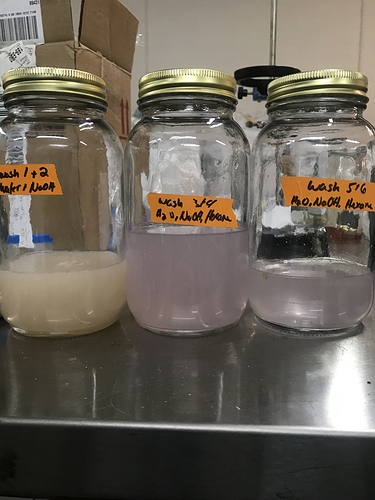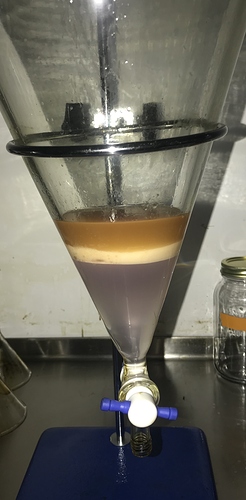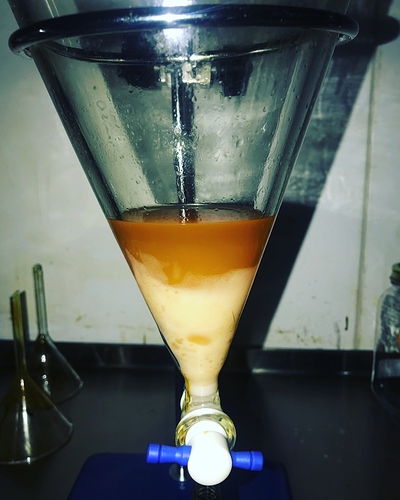This months med run proceeds after a dewaxing process which left the compound dewaxed and disolved in Methanol. A 100 ml addition funnel used as a sep funnel was used. Starting crude concentrate before refinement and dewaxing was one ounce. I chose to start with 50 ml of hexane on the premise that about two milliliters hexane to one gram of extract would be enough to easily hold it in solution. My rule of thumb is one gram of extract equals about one milliliter of liquid.
On the left is the compound in a methanol solution. The sep funnel is smaller than I would like but my next size is 500 ml so I elected to do this in multiple steps in a smaller unit. Shown are the deionized water, the hexane, and the methanol used.
Here is the sep funnel loaded now with clean and pure hexane. Hexane and methanol are immiscible. Hexane and water are immiscible. Methanol and water are miscible in each other. This means that hexane will always form a layer above water or methanol. For LLE to work it does not matter if you use two, or three or more solvents so long as the compound of interest is miscible in both layers but both layers formed are not miscible in each other. I take advantage further that cannabinoid is not miscible in water and add this as a “crashing” tool of sorts for both the methanol to leave the hexane and the cannabinoid to leave the methanol.
![]()
My point in explaining this is that LLE has unlimited potential ways to exploit solubility and it is pretty darn cheap if your most used solvent is water and hexane budget is just two milliliters per gram of extract if you do not recover solvent. Plus I just vaped some primo oil and it’s fun explaining minute detail when savagely enjoying a good high. ![]()
Methanol will compete with hexane for cannabinoid until you add water. Then the water and Methanol combine preferentially excluding cannabinoid but not excluding generally the light boiling terpene fraction and other more polar compounds.
So the idea is to transfer the cannabinoid from all the methanol into the clean hexane and flush the methanol, water, and more polar compound and terps out of the mix.
Now the methanol with cannabinoid is added. You can see two layers competing for the cannabinoids. I plan a distillation so will seperate various cannabinoids there but as always interesting layers emerge. This is before the introduction of the first bit of water. Hexane layer on top and methanol layer below.
Now the water has been added and this action will cause the Methanol to seperate from nearly all cannabinoid. Look at the close up. A third layer forms at the junction of solvents that does not seem to be emulsion. It is a seperate distinct layer and I do not know why it does that precisely lolz.
Once the water runs clear the majority of the methanol has been removed. Shown here is the first bit of compound that was run through the hexane layer which provides intimate solvent/solvent contact. The catch flask on the left contains water, methanol, and terpenes/other that seperated. The clear layer in the addition funnel indicates that more Methanol and compound needs to be added into the hexane and the water wash then continues this way until all cannabinoid has been transferred from the methanol to the hexane.
Here now the last of the cannabinoid has been transferred from the methanol solution to the hexane. Shown is the amount of water and methanol collected. It started at approximately 500 ml of methanol with the compound in solution. It took a bit more than just a few liters to flush the methanol out of the hexane. Note how dark the hexane layer has become from the cannabinoids.
The white flasks will be set in the freezer. Residual cannabinoid will harden and stick to the glass. The water and methanol will become chalk white and be discarded. Residual cannabinoids will be gleaned from the catch flasks in a future lab. Likely about a quarter to a half gram or so might be recovered that way later.
The hexane is then loaded into the bottom half of the cryogenic sublimation apparatus and is allowed to evaporate in preparation for distillation.











